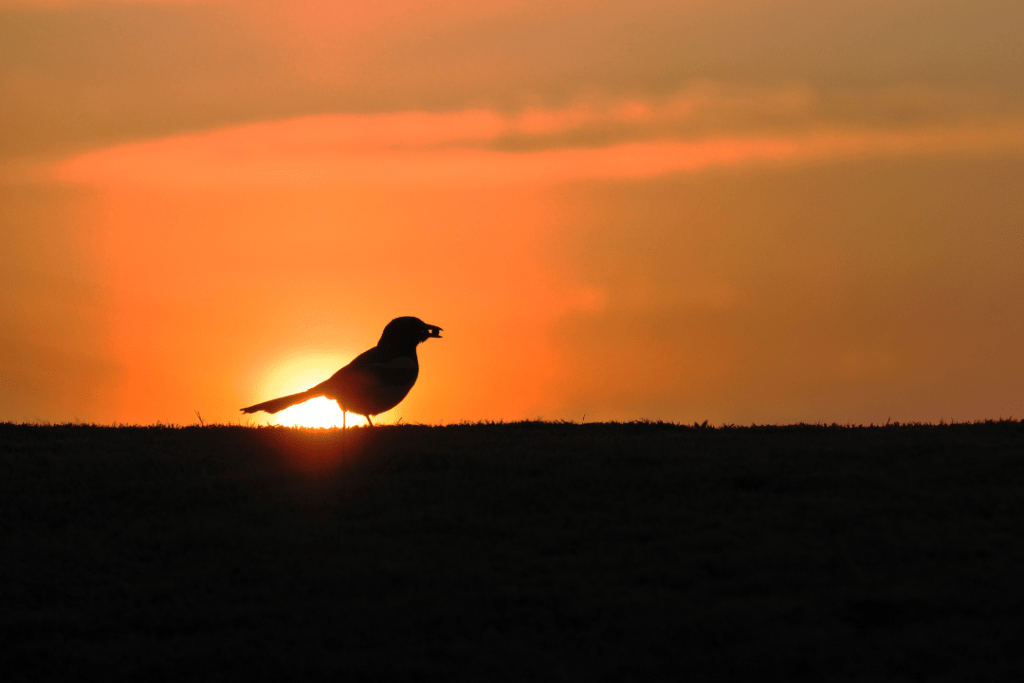
If you’re used to sleeping in and you happen to step outside at 5 am one morning, you might be amazed by what you hear—your neighborhood birds singing and chirping like there’s no tomorrow.
Many birds sing most intensely as the first rays of sunshine break through the morning sky. This is known as the “dawn chorus.”
The dawn chorus is a global phenomenon, common among all sorts of birds. However, we don’t fully understand why birds are compelled to sing with such vigor at the start of each new day.
Let’s explore all there is to know about how and why birds sing so loudly in the early morning, including:
- During which part of the day are birds most active?
- What types of birds sing and chirp in the morning?
- Why do birds sing so loudly in the early morning?
During Which Part of the Day Are Birds Most Active?
Birds and other animals are classified by which time of day they’re most active.
Birds may be:
- Diurnal: primarily active during the day, sleeping at night
- Nocturnal: primarily active during the night, sleeping during the day
- Crepuscular: primarily active during twilight

The species most associated with a nocturnal schedule are owls. Owls have excellent vision and hearing and they’re able to fly with nearly-silent wing flaps. These traits make them the perfect nighttime predators for the rodents they hunt, which are also nocturnal.
A few species, like the American Woodcock, are considered crepuscular. Concentrating activity in twilight hours helps some animals fill an ecological niche, avoid nocturnal predators, and make the best use of their unique camouflage patterns.
Most songbirds, like sparrows, robins, and cardinals, are diurnal.
Songbirds are most active between dawn and dusk. Requiring light for finding food means that the nighttime is best spent sleeping.
The most important and time-consuming daily activity for a songbird is feeding. Other time is spent on activities like nest-building, bathing, and courtship.
Singing and chirping occur throughout the day—but songbirds are noisiest in the morning.
Which Birds Sing and Chirp Loudly in the Morning?
The dawn chorus occurs all around the world. All types of birds that sing and chirp wake up early and begin enthusiastically exercising their vocal cords.
Some species wake up extra early and start making noise as early as 3 am. For most, singing begins around 4 or 5 am and peaks around 6 am.
From the mournful coos of doves to the cheerful chirps of bluebirds, the dawn chorus contains all sorts of sounds.
Some species, like robins, blackbirds, pigeons, and thrushes, are known as extra-early risers and particularly enthusiastic morning singers. However, all of your familiar backyard birds are probably participating in your local chorus.
What Types of Birds Begin Singing First?

When researchers study a particular habitat’s morning bird songs, they’re able to determine the order in which different songbird species start to vocalize.
These two factors seem to play a role in predicting which birds sing earliest:
- Eye size
- Tree canopy position
Larger eyes catch more light, making it easier to see in the dim morning. Birds with large eyes (in relation to body size), such as robins, tend to wake up early.
An Ecuadorian rainforest study found that birds that look for food higher up in the tree canopy tend to be early risers.
Light hits the treetops before it reaches the ground, thus bringing an earlier morning to high-perching birds. This trend might be less noticeable outside of rainforest habitats since vegetation in most places is less dense.
If you’re curious about which birds are making all that noise around your house every morning, try the Merlin bird ID app. You can upload the sounds you’re hearing into the app and receive identification suggestions.
Why Do Birds Sing and Chirp in the Early Morning?
If you live in a city or the suburbs, you might wonder if the dawn chorus is an adaptation to human-filled environments. Perhaps birds are taking advantage of the quiet morning hours before human noises flood the sky and drown out their calls.
However, the dawn chorus occurs in all sorts of settings. From New York City pigeons to Amazon rain forest toucans, most singing birds are noisiest at dawn.
We don’t fully understand why the dawn chorus occurs. Many birds sing and vocalize throughout the day, but it’s not entirely clear why they sing with such gusto in the early morning. However, in recent years, research has begun to explain the phenomenon.
Let’s visit a few theories that have been proposed to explain the dawn chorus.
The Dry Morning Air Theory
Until recent decades, the dawn chorus was thought to be mainly connected to morning environmental conditions.
First, when many birds wake up, it’s still too dark to find food. Free time and empty beaks lead to more singing.
Second, it was thought that morning air quality led to a better acoustic atmosphere.
In the morning, the air is cooler and drier and there’s less wind.
The common belief used to be that bird songs traveled further in these conditions. Therefore, morning singing by males could be used to reach the ears of more potential mates while also sounding a far-reaching territorial call against other males.
Scientists eventually determined that morning air conditions don’t actually carry bird songs further than during other times of the day.
Singing loudly in the morning on an empty stomach might be a good way for a male bird to show off its strength. However, air quality is no longer considered a primary explanation for the dawn chorus.
The “Early Bird Gets the Mate” Theory
Both male and female songbirds chirp and sing. However, generally speaking, males are noisier.
One explanation for the dawn chorus involves the good health that males can exhibit by singing early in the morning.
Singing on an empty stomach while nocturnal predators are still on the prowl exhibits strength and confidence. In theory, energized singing at this time of day sends a powerful message to desirable females and rival males.
In other words, a self-assured bird is a noisy bird.
This principle isn’t limited to songbirds. Researchers who studied the dawn-breaking calls of roosters found that each morning, stronger roosters are the first to crow. Takashi Yoshimura, the study’s co-author says:
“Crowing is a warning signal advertising territorial claims… The highest ranked rooster has priority in breaking the dawn, and lower [ranking] roosters are patient enough to wait and follow the highest ranked rooster each morning.”
Compared to roosters, songbirds might be less willing to wait their turn, but just as eager to announce their presence to potential mates and rivals.
The Vocal Warm-Up Theory

Recently, bird experts have begun to view the dawn chorus as a form of “warming up.” Just like the members of an orchestra have to run through some scales before a concert, waking birds need to ease their voices into peak form.
Bird songs can be incredibly complex, fast, and loud. Turns out, birds don’t simply roll out of bed ready to hit their notes perfectly.
For male birds, singing is a competitive sport. To impress the females, these two difficulty factors are in play:
- The range of notes
- The speed at which the range of notes can be sung
Hitting a broad range of pitches involves opening the beak extra wide. Hitting lots of notes in rapid order involves opening and closing the beak quickly. The wider and faster a bird can open and close its beak, the better the song.
Duke University researchers studying swamp sparrows found that these birds start off their dawn chorus by singing slowly in a limited range of notes.
As the morning went on, their songs grow faster and reach a broader range of pitches. The more warming up a swamp sparrow does, the more “improvement” his song exhibits by the end of the morning.
Jason Dinh, one of the study’s authors, describes it like this:
“It’s like they’re warming up backstage, before the sun comes up and the curtain rises.”
It’s understood that well-performed bird songs are more attractive to females and more threatening to other males. Therefore, it’s worth taking some time each morning to practice.
According to the vocal warm-up theory, the dawn chorus is just a daily rehearsal—songbirds tuning their instruments for the day to come.
Enjoying the Dawn Chorus
Every experienced birder knows that dawn is an ideal time for seeing and hearing songbirds. The early morning provides an ideal window of time where wildlife is out and about, human activity is limited, and there’s enough light to see the action.
Since 1987, the first Sunday of May is celebrated as International Dawn Chorus Day. On this day, birdwatching events are organized around the world for “a celebration of nature’s symphony.”
While early May is an excellent time of year for birding, the dawn chorus can be heard year-round. Wherever songbirds are found, you can count on a noisy, joyful morning concert.

Kelly is an environmental science writer, naturalist, and birdwatcher. Kelly holds a master’s degree in environmental policy and has worked as an environmental analyst, urban planner, and professor of environmental planning.
